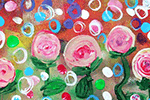The Children's Art Book
Mixing Acrylic Colours
Keep your paints wet and workable by mixing paint with some water, and if you need to, cover your palette with a lid to prevent drying out. Here are some other basics to get your child started on mixing acrylic paints.
Mixing colours on a palette
One of the most obvious method of mixing colours is to do it on a palette. Using an ice cream stick or spatula, fold different colours until a homogeneous consistency.
Try mixing paints in cleaned and old plastic egg trays or plastic food containers. It’s makes a fun recycling activity for your child with much less to wash at the end!
Brief and incomplete mixing of colours
If you want to get an interesting mingling effect. Instead, mix them briefly then apply the swirls of paints directly onto the canvas! The colours not only appear more fascinating, but also creates exciting tones and shades for more realism.
Partially mixed paints work well when painting fruits, plants and abstract art.
Create a family palette of colours
Don’t just stop once you have mixed to your intended colour. Add tiny swirls of paint in varying amounts to create a family of colour tones and shades that can help create beautiful subtleties in the painting.
Having a family of colours on prepared on a palette visually encourages children to use more variety, and are especially fun on skin tones of people and animals. You can even come out with a cool name to your child’s unique family of colours!
Reinforce colours by adding white
Not all acrylic paints are made the same. Some paints may be more opaque than others from a different brand, or even a different colour of the same brand. Adding some white paint to most colours will make them more vibrant and robust with greater opacity.
Try adding some white to greens, reds, yellows and browns the next time to make these colours pop! Children would appreciate more opaque acrylic paints, since translucent paints often require painting additional layers (and effort!)
Avoid using black to darken colours
If white lightens colours, the converse must also be true. What faster way to get darker shades than to use black?
Instead, add brown, dark blue or darn green. While this appears counter-intuitive, the new colours will appear more true to life. Mixing black to darken colours create unnaturally dull and muddy looking colours.
If you do need to darken colours, add tiny swirls each time. You cannot salvage colours that are too dark with white!
Store mixed colours in old containers
Next time you finish that chicken essence or snack jar, be sure to wash and keep the containers. Acrylic paints even when diluted will dry out if left to air, so store your perfectly mixed colours in lid covered containers.
Depending on how thick the paint is, acrylic can dry out within minutes! Put a lid on if you are temporarily away, or store in airtight containers if you need to be save the colours overnight. Don’t do the same for paint brushes though, since dried acrylic paint on the bristles are almost impossible to remove!
Don’t lose on the opportunity to teach children about art discipline by caring for their tools and paints.











